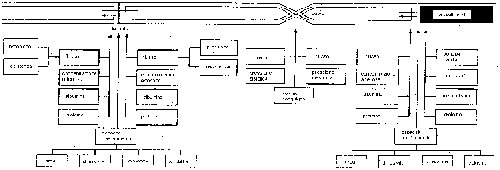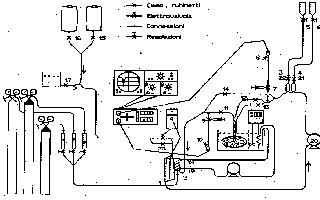
Abstract
The fetoplacental blood circulation has been object of interest for several years.
The placenta can support life and feeding of the fetus during the pregnancy:
it grows up with it, and concludes its functions at the childbirth.
In particular it replaces the breathing organs, it allows the exchange
of food and of waste substances, also driving the temperature of the fetus,
when the central nervous system still cannot provide this function.
Anyway final answers to many questions are still pending.
For instance the microscopic structure of the placenta during the pregnancy
and the internal distribution of the blood flow have not yet been totally
clarified.
More complex questions, clearly not yet easy to analyse, regard the
exchange of organic substances.
Answers to these questions, if reliable enough, could clarify the disputes
concerned with the fetal blood oxygenation and about the causes of many
pathologies of pregnancy, still with unknown aetiology.
Presently the knowledge concerning problems as IUGR (Intra-Uterine
Growth Retardation), toxicology and teratology, is still lacking in sound
experimental confirmations.
Moreover the clinic research doesn't allow to stride along this direction
because, for ethical reasons, invasive experiments over the fetus are not
proposable.
Speaking about indirect measurements, the Doppler velocimetry made
it possible to describe the blood flow characteristics of the fetal side
and of the maternal side of the placenta, but the presently available instruments
can afford measurements affected by tolerances reaching 35% and, quite
important, the reliability of the results is depending by the competence
of the operator.
Research adopting direct measurement techniques, drugs and radio-active
substances have been done on animals, but the results are not convincing:
it was better discovered that each animal species developed a different
type of circulation, during the evolution. Anyway a certain resemblance
between the human and the ovine placenta has been observed.
The target of this work is to study the fetoplacental circulation through
a model that has been designed mainly on the basis of the actual knowledge
about the placental vessels. The most interesting point is the possibility
to apply the model to modern systems of clinical analysis, to perform medical
examinations able to early detect some pathologies of the pregnancy. This
study was supported by the design and realization of perfusion techniques
that allowed the verification of the hypothesis that were introduced into
the theoretical model.
The experimentation involves technical problems, also because the placenta
is the junction of two different but partially interdependent organisms,
and each of them can influence its functioning.
Anyway, during the experimentation, several clinical variables can
be easily controlled: this allows to neglect some of them, simplifying
the starting hypothesis, and to analyse separately some other ones. Figure
n.1 shows the variables involved for the mass exchange during the pregnancy.

This thesis is composed by four parts:
The first part briefly describes the placental physiology and some
pathological conditions, and the diagnosis instruments.
The second part takes in examination the realized perfusion systems,
dwelling on the testing protocol. Our experimentation has been carried
out at the gynaecology and obstetrics ward of the San Paolo hospital, Milan,
in collaboration with the medical staff.
The third part is dedicated to the analysis of a simulation model of
the placenta.
To be clearer on problems that are not common to medicine and to engineering,
we deemed it necessary to add a glossary in the fourth part, to explain
the technical terms, with some conversion tables for units of measure currently
used in medicine.
The goal of the study was not simply limited to the development of a
model, but it took advantage of a prior huge experimentation that contributed
to verify the hypothesis of placental working, suggesting methods of analysis
and measurement of the vascular characteristics, up to now performed only
in extremely partial way.
The first part is introductory, it is aimed to introduce the elemental
concepts on placental physiology and morphology. In the second part of
this work the experimentation executed at S. Paolo hospital, Milan, is
described. It has been developed during about 50 sessions, and it permitted
to develop and set-up a reliable and accurate method of research. This
allowed to study and verify the characteristics of the human placenta fluidodynamics.
Soon after the child-birth and the drawing the placenta was connected to
a perfusion set, able to simulate the physiological perfusion condition
at the 38st week of gestation. An oxygenator maintained the concentrations
of oxygen and carbon dioxide of the blood at physiological level.
The circuit realized in this way allowed to perform a controlled perfusion,
with known parameters about input and output flow. The perfusion fluid
was bovine blood, with physical characteristics similar to the fetal blood
ones, instead of alkaline solution, as done by other researchers.

Our perfusion circuit has been utilised also to perform a successive
set of tests, using a solution with formaldehyde and glutaraldehyde instead
of blood. This type of 'fixing' perfusion has been extended averaging 23
minutes, with a flow ranging 100 to 250 cc/min, measuring an arterial pressure
always lower than 120 mmHg. The analysis, performed with the microscope,
of the placentas that have been fixed in this way confirmed the very high
quality of the perfusion, and finally the accurate measurement of the gauge
of placental in-pressure vessels was possible. The obtained data, regarding
the first orders of vessels, don't match the data of the medical literature.
In particular the latter group of figures is burdened with deficiency errors.
These miscorrelations are essentially due to the adopted methods of measurement.
So, the developed device can be a valid support for a morphometric
and anatomic study of the placental vascular net, unlike the previous studies,
where the vessels have almost always been fixed and analysed at rest, that
is a not-physiological situation.
The obtained values are part of the data that have been used to design
the model. This is described in the third part of this work.
Preliminarily an extensive search for the required quantitative information
about the morphology of the vessels has been held. The comparison of these
data with the obtained ones allowed to define the size of each order of
vessels. Finally we elaborated a table to determine the resistances and
of the hydraulic capacitances of the model of fetoplacental circulation.
The model, realised using an equivalent electric circuit, was firstly
applied to study the fluidodynamics of the fetoplacental circulation in
the physiological situation, then in pathological situations, associated
to infarction of vessels in rising percentage. The obtained graphs, relating
to the flow in umbilical arteries and in fetal aorta, in physiological
condition, are extremely interesting, because the match exactly the actual
Doppler velocimetry waveforms: they are in favour of the choices that have
been made to develop the mathematical model. So, the model revealed itself
to be useful about a physical interpretation of the Doppler waves and about
the various types of empirical pulsatility index used in the medical field.
The flow diagrams obtained simulating pathological situations give
remarkable discussion points. There is a strong likeness between the result
of the model and the collected medical data (variations of the typical
data regarding waveforms and adimensional indexes). Moreover some effects
and peculiarities of the flow modifications are emphasized. They have not
yet been investigated enough: they can give prospects of development if
experimentally verified.
In particular, increasing the degree of simulated pathology, the model
doesn't show a decrease of pulsatility in the umbilical arteries, as wrongly
showed by the previous models. On the contrary the waveform persists nearly
unchanged, and the decrease of the instant flow at the end of the diastole
(minimal value) happens more quickly than the corresponding decrease of
the mean flow, as in the clinical data. The variations on the mentioned
flow parameters are quite weak (lower than the accuracy of the currently
used instruments) in case of slight pathological situations (15% of infarction),
and the adimensional index PI, A/B and RI are not able to express well-timed
diagnosis, as their significant shifting from the physiological-considered
values happens only in case of pathologies reaching 30, 40% of the placental
vessels. They produce a decrease of the mean flow greater than 10%, corresponding
to pathologies that are already effective and compromising the functionality
of the placenta.
Moreover we noticed an extremely interesting decrease of time delay
between heart beat and systolic peak in the umbilical arteries when the
pathology worsens. The course of this delay is quasi-linear. It assumes
sizeable values (-7%) already with 15% of occluded vessels, thus even before
similar variations in the characteristics of the Doppler flow waveforms
occur. This phenomenon has not yet been observed in the medical field,
but it can be checked by the current instrumentation set, and it is independent
by the insonation angle and by the vessel gauge.
The model shows a substantial correspondence with the vascular structure of the fetoplacental cardiocirculatory system. It allows not only to make comparisons with already known results and methods, but it gives way to bring an original contribution suggesting more accurate and suitable diagnosis methods.
The flexibility and the powerful computational skill of the program
suggest important possible developments for various types of analysis:
more localised pathologies, pathologies altering the histological structure
of the vessels (if able to change their elastic constant), physiological
situations not at term.
The introduction of the tuning system for the cardiac flow versus the
arterial pressure is an interesting investigation, that may offer valuable
results. To remove the hypothesis of fixed flow does not involve any difficulty
for the modification of the equivalent electric net, and it allows to introduce
an optimisation work in order to obtain closer to the real situation results.
During the two years we spent since when the outline of this work was
traced, we referred to a big number of people, often taking advantage of
their patience, to get information, materials and favours.
Among them we should like to mention dott. Alessandra Pavesi, who followed
the experimentation providing the essential link between the medical staff
and us, and dott. Gaetano Bulfamante, the pathologist who performed the
tests vouching for the validity of the experiments.
| Abstract |
Index |
Download |
Links |
Contact us |